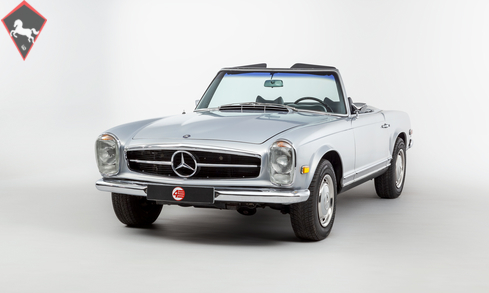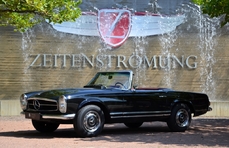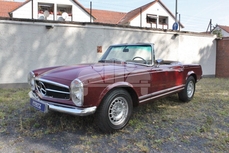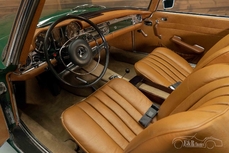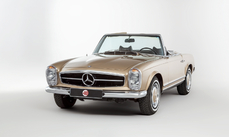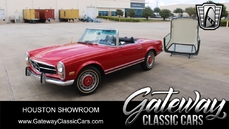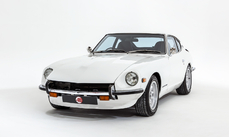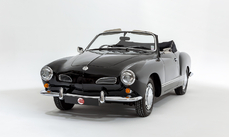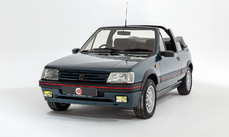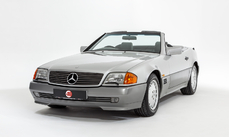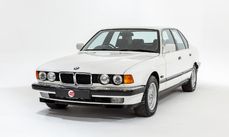Mercedes-Benz 280SL w113 Pagoda 1969
General description :
Model History
The Mercedes-Benz W113 was a two-seat roadster/coupé produced from 1963 through 1971. It was introduced at the 1963 Geneva Motor Show and replaced both the legendary 300SL (W198) and the 190SL (W121). The model is well known for its distinctive slightly concave hardtop, which inspired the “Pagoda” nickname.
All W113 SL models were equipped with a straight-six cylinder engine with multi-port fuel injection. The bonnet, boot lid, door skins and tonneau cover were made of aluminium to reduce weight. The comparatively short and wide chassis, combined with an excellent suspension, powerful brakes, and radial tires gave the W113 superb handling for its time. The styling of the front, with its characteristic upright Bosch “fishbowl” headlights and simple chrome grille, dominated by the large three-pointed star, paid homage to the then already legendary 300SL roadster.
The W113 280SL – as featured here – was produced from December 1967 until February 1971 when it was replaced by the R107 SL.
Equipment
Metallic silver paintwork, Leather upholstery, Removable hardtop in dark blue, Folding soft-top in dark blue, 4-speed automatic gearbox, Air conditioning, Power steering, Becker radio, Lockable glove compartment, Dash clock, Carpet mats, Rubber boot mat, Cigar lighter, Ash tray, Spare wheel with cover, Spare key.
Exterior
The simple, elegant lines of the SL Pagoda look wonderful in timeless metallic silver. The gleaming bodywork presents to a very high standard all round, with even panel gaps and a deep uniform shine to be found. The car is entirely free from any rust issues and boasts one of the cleanest W113 undersides we have ever seen, fully protected by a clear coat of Waxoyl (photos available upon request). All brightwork and trims are in equally fine fettle, retaining a lovely mirror finish on close inspection. The lights are without any cracks or signs of moisture ingress, and the blue soft-top is free from any wear. The hard top is finished in contrasting dark blue and presents in excellent condition inside and out.
VIEWINGS WELCOME BY APPOINTMENT ONLY /// ADDITIONAL PHOTOS AVAILABLE UPON REQUEST
Interior
With the classic design of the dashboard, chrome fittings, switchgear and over-sized steering wheel, the Pagoda’s glamourous interior does not disappoint. The dark leather seats are both in excellent condition with almost no wear to be found, and the grey woven carpets are spotless throughout. Other nice features include an original Becker radio and fully functioning air conditioner unit. In the boot area you’ll find the covered spare wheel and original rubber load mat.
ENGINE & TRANSMISSION
The engine bay is extremely well presented throughout, retaining a fresh appearance with no signs of any damage or poor repair. The 2.8-litre straight six is remarkably smooth on test and the 4-speed automatic gearbox operates without fault. We have just had the car serviced, inspected, and MOT’d for the new keeper’s peace of mind.
WHEELS, TYRES & BRAKES
The SL sits on original 14-inch steels fitted with pristine body-coloured wheel trims. The matching Goodyear tyres show plenty of tread remaining and the brakes do a fine job of stopping the car quickly and in a straight line.
History File
The SL was built in December 1968 and subsequently registered in early 1969. The History File is complete with an original Mercedes book pack including service booklet, owner’s manual, service policy booklet, Mercedes dealer directory, and Becker instruction booklet. More recent documentation includes a Date of Manufacture letter from Mercedes, import and registration documents, MOT certificates, and invoices for recent maintenance.
http://www.4starclassics.com/for-sale/mercedes-280sl-pagoda-for-sale-2/
1969 Mercedes-Benz 280SL w113 Pagoda is listed sold on ClassicDigest in Kingsley by 4 Star Classics for £99995.
Car Facts
Car type : Car Make : Mercedes-Benz Model : 280SL w113 Model Version : Pagoda Engine size : 2.8 Model Year : 1969 Sub type : Convertible Location : Hampshire
Sold
Seller Information
Sold
People who viewed this Mercedes-Benz 280SL w113 also viewed similar Mercedes-Benz listed at ClassicDigest
Other cars listed for sale by this dealer
About Mercedes-Benz
In the annals of automotive history, the journey of Mercedes-Benz is a tale that unfolds with the ingenuity of its founding pioneers. In the year 1886, Karl Benz crafted the Benz Patent Motorwagen, a creation that would go down in history as the world's inaugural automobile. Unbeknownst to him, this moment marked the genesis of what would evolve into the most illustrious premium car manufacturer globally. The financial underpinning of this pioneering venture, interestingly, was provided by Karl Benz's wife, Bertha Benz, demonstrating a remarkable partnership that would set the tone for Mercedes-Benz's legacy.A parallel narrative emerged not far away, as Daimler-Motoren-Gesellschaft, founded by Gottlieb Daimler and Wilhelm Maybach, entered the scene. In 1901, they unveiled their automobile under the now-famous moniker "Mercedes," meaning "godsend" in Spanish. This name was bestowed upon the car at the behest of Emil Jellinek's daughter, the distributor for Daimler-Motoren-Gesellschaft. The wheels of innovation were set in motion.
Fast forward to 1926, a pivotal year that witnessed the merger of Daimler with Benz & Cie., culminating in the birth of Daimler-Benz. The amalgamation saw the adoption of "Mercedes-Benz" as the distinguished trademark for their automobiles, fusing the legacies of two visionary entities into one.
Contrary to perceptions of conservatism, the trajectory of Daimler-Benz unfolds as a chronicle of industry firsts. From the introduction of the honeycomb radiator to the float carburetor, and the pioneering implementation of four-wheel brakes in 1924, Daimler-Benz consistently pushed the boundaries of automotive innovation. The diesel-powered Mercedes-Benz 260 D in 1936 marked the inception of diesel engines in passenger cars. The iconic Mercedes-Benz 300SL Gullwing made history as the first car with direct fuel injection, albeit the Gutbrod's tiny 2-stroke engine can claim precedence.
Safety innovations became a hallmark, with Béla Barényi's patented safety cell design in the "Ponton"-models in 1951, featuring front and rear crumple zones. The W116 450SEL 6.9 saw the introduction of the Anti-Lock Brake system (ABS), another pioneering safety feature. From the first production airbags and beyond, the legacy of "firsts" continued to be etched into the fabric of Daimler-Benz.
Over its centennial journey, Mercedes-Benz has not merely produced cars but has sculpted automotive icons. The SSKL, 710 SSK Trossi Roadster, 770K Grosser, 540K Spezial Roadster, 300SL Gullwing, w100 600 Pullman, w111 280SE 3.5 Flachkühler, w113 230SL Pagoda, w109 300 SEL 6.3, and w201 2.3-16 Cosworth stand testament to the brand's commitment to engineering excellence.
The roaring Silver Arrows, or "Silberpfeile," including the W 25, W 125, W154, W165, and W196, created a legacy of dominance on the racetrack. These machines were not merely cars; they were expressions of precision, speed, and an indomitable spirit that left their competitors in the dust.
As Mercedes-Benz marches into the future, it does so not just as an automaker but as a custodian of a legacy, a torchbearer of innovation, and a beacon of automotive excellence. The road ahead is sure to witness the continued fusion of cutting-edge technology, timeless design, and an unwavering commitment to setting new standards in the world of automobiles.
One luminary figure who left an indelible mark was Béla Barényi, often heralded as the "father of passive safety" for his pioneering work in safety engineering. His patented safety cell design, featuring front and rear crumple zones, became a hallmark of Mercedes-Benz's commitment to occupant safety, setting new standards that reverberated throughout the automotive world.
Moving through the chronicles, the collaborative genius of Wilhelm Maybach, alongside Gottlieb Daimler, laid the foundation for Daimler-Motoren-Gesellschaft. Their innovations not only birthed the first Mercedes but established a culture of relentless pursuit of technological excellence that remains integral to Mercedes-Benz's DNA.
In the post-merger era of 1926, Ferdinand Porsche emerged as a prominent figure within Mercedes-Benz. His work on the Mercedes-Benz S-Type, a supercharged race car, garnered acclaim and set the stage for a legacy that extended far beyond the marque. Porsche's impact would later extend to his eponymous company, but his influence at Mercedes-Benz during those formative years was pivotal.
As the 20th century progressed, the legendary Rudolf Uhlenhaut emerged as a key figure. Uhlenhaut, an accomplished engineer and the driving force behind the iconic Silver Arrows, played a crucial role in Mercedes-Benz's dominance in motorsports. His engineering prowess and attention to detail were instrumental in creating some of the most formidable racing cars of the era.
In the latter half of the century, figures like Bruno Sacco, the head of design at Mercedes-Benz from 1975 to 1999, left an indelible imprint on the brand's aesthetic identity. Sacco's design philosophy, characterized by clean lines and timeless elegance, shaped iconic models like the W126 S-Class and the W201 190E, solidifying Mercedes-Benz's reputation for luxury and sophistication.
The narrative would be incomplete without acknowledging the contributions of engineers like Hans Scherenberg, whose leadership in the 1970s ushered in a new era of technological innovation at Mercedes-Benz. Scherenberg's tenure saw the development of groundbreaking technologies, including the Anti-Lock Brake system (ABS) and the introduction of airbags in production cars.
